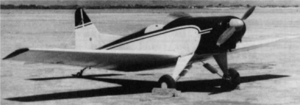Engineering:Okamura N-52
From HandWiki
Revision as of 15:21, 11 April 2022 by imported>WikiGary (over-write)
| Okamura N-52 | |
|---|---|

| |
| Role | Homebuilt aircraft |
| National origin | Japan |
| Manufacturer | Okamura Mfg. Co. |
| Designer | Hidemasa Kimura, Nihon University College of Science and Engineering |
| First flight | April 7, 1953 |
| Introduction | 1952 |
The Okamura N-52 is a low-wing, side-by-side seating sport aircraft, that was designed in Japan by students.[1]
Development
The N-52 Started as a design experiment at Nihon University. Three test airframes were funded by Asahi Press for analysis.[2]
Design
The N-52 is powered by a Continental A-65 engine. The aircraft features a single open cockpit with side-by-side seating and a taildragger landing gear. The aircraft was designed to accommodate up to 100 hp (75 kW) engines. Controllability with a 65 hp (48 kW) engine was considered sluggish.[3]
Specifications (Okamura N-52)
Data from Sport Aviation
General characteristics
- Crew: one
- Capacity: one passenger
- Length: 5.99 m (19 ft 8 in)
- Wingspan: 8.61 m (28 ft 3 in)
- Height: 2.59 m (8 ft 6 in)
- Wing area: 12.0 m2 (129 sq ft)
- Empty weight: 299 kg (660 lb)
- Gross weight: 499 kg (1,100 lb)
- Powerplant: 1 × Continental A-65 air-cooled four-cylinder horizontally-opposed engine, 48 kW (65 hp)
Performance
- Maximum speed: 180 km/h (110 mph, 96 kn)
- Stall speed: 79 km/h (49 mph, 43 kn)
- Rate of climb: 2.8 m/s (550 ft/min)
See also
Aircraft of comparable role, configuration and era
References
 |

